The 1950s camera industry was known for two major events, the first was the rise of Japan’s dominance in the market. What was just a curiosity in the years before, during, and immediately after World War II, by the end of the 1950s Japanese cameras were outselling many German models by a large margin. In just a few short years, a large number of camera makers that most westerners had never heard of appeared out of nowhere, making everything from top of the line rangefinders, medium format twin lens reflexes, to inexpensive point and shoots.
Although the German camera industry would resume some of its prewar dominance, as each year passed, German camera makers found themselves losing market share as more and more Japanese companies became more adept at building high quality cameras and lenses faster, for less money, and using less parts. Although it could be argued that many Japanese designs were heavily inspired by German designs or that they were function over form, there’s no denying that the Japanese were good at making cameras.
The 1950s also saw a swift change in preference from 35mm rangefinders to Single Lens Reflex designs as new models were introduced that eliminated many of the usability issues that hampered early German SLR designs. Instant return mirrors reduced viewfinder blackout to just a fraction of a second, finer ground and eventual Fresnel etched focusing screens improved viewfinder brightness from the dreary dim viewfinders of early SLRs, and cameras with automatic diaphragms eliminated the step of manually having to stop down a lens before each exposure was made.
With such a huge number of new models being released in a short period of time, it was easy to miss what every company was doing, but with the benefit of more than a half century to look back at this hugely innovative period, I thought it would be fun to rank each Japanese manufacturer’s first attempts at a 35mm SLR. Of course, any time anyone on the Internet ranks anything, you’re bound to ruffle some feathers so I’ll explain my ranking system.
I chose each manufacturer’s first commercially available model released under that manufacturer’s own name. That means prototypes or cameras with an extremely limited production aren’t included, nor are later models which might have been significantly improved from an earlier model.
My ranking is based on three different criteria:
- Did they get it right? – Each of these models were a first for the respective company who made them. Since these were new designs, what features the cameras did or didn’t have weren’t unanimous across the board, nor were the ergonomics. By the 1960s, most SLRs shared a similar design, but that wasn’t true a decade earlier as consumer preferences weren’t yet known. What I’m looking for is how good of a job did the manufacturer do in creating a camera that people wanted on their first try.
- Legacy – It is one thing to build one nice camera, but it is another to have a lasting impact not only on your own company’s future designs, but also the industry as a whole. Models that introduced a new feature never before available which would soon appear on competing models have a positive legacy, as do cameras which spawned many other successful models in that company or other company’s lineups.
- My opinion – I have been fortunate to handle and shoot almost every model mentioned here. For the few that I haven’t, I’ll judge this category based on my impressions of the camera by reading other reviews, and by shooting very similar cameras by that same manufacturer.
With my criteria and motive set, here is my ranking of 14 different first SLRs by Japanese camera makers in reverse order.
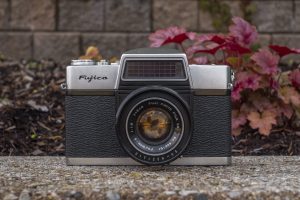
Fujica Fujicarex II (1963)
Check out my review of the Fujica Fujicarex II.
Whenever you have a ranked list of anything, someone has to be at the bottom, and in the case of first Japanese 35mm SLRs, the Fujica Fujicarex II is that camera. Fuji made quite a number of great cameras in the 20th century. Fuji produced medium format folders that shot 4.5×6, 6×6, 6×7, 6×8, 6×9, and even a monster 6×17 panoramic camera. Fuji also made a good number of 35mm rangefinders and half frame cameras like the Fujica 35SE and Fujica Drive, many of which I have reviewed here positively.
I consider myself a fan of Fuji and their cameras, but unfortunately their first 35mm SLR was a stinker. A uniquely designed camera that used a Citizen leaf shutter, a fixed pentaprism, and a unique thumb wheel for both focus and aperture control, Fuji definitely went in a new direction with this camera. The problem is, they went in the wrong direction.
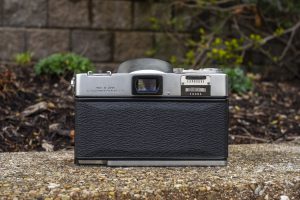
As neat as it sounds to have dual thumbwheels on the back of the camera for focus and aperture control, in use, it was very awkward. In my time shooting a test roll with the camera, I could never get used to the ergonomics and found the viewfinder’s interesting dual split image to be difficult to focus with, and I suspect original owners of these cameras felt the same way.
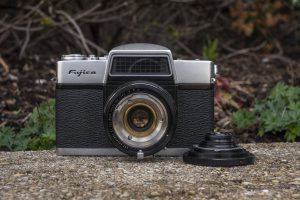
The Fujicarex II came with a quality 6-element 5cm f/1.9 Fujinon-S lens that was capable of sharp and good looking images, however it wasn’t fully interchangeable. Instead, the camera used a front group design in which part of the lens could be swapped out with accessory lenses, modifying the focal length, while sharing some of the original 6 elements from the standard lens. This is similar to how later Kodak Retina rangefinders and the first Kodak Retina Reflex worked.
Another curiosity of the Fujicarex was its name. That it is called the Fujicarex II suggests it was an update to a Fujicarex I, but most research online suggests the original Fujicarex was a Japanese only model and when the camera was sold for export, its name was changed to Fujicarex II without any other changes to make the camera appear new and fresh. This type of “name engineering” is not only low brow, but it also suggests that perhaps Fuji wasn’t totally committed to the camera.
The Fujicarex II sold poorly and disappeared from the market quickly. It was such a disappointment, Fuji would wait seven years before releasing another 35mm SLR, the good, but not very ambitious Fujica ST701 in 1970.
Fuji would later go on to produce a solid lineup of 35mm SLRs in the 1970s and early 80s, but would never really gain a foothold as a leader in this market, and whatever success they had with later SLRs, none of them shared anything in common with the Fujicarex II, and for good reason.
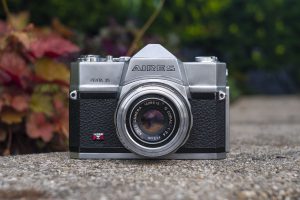
Aires Penta 35 (1959)
Check out my review of the Aires Penta 35.
In some ways, the Aires Penta 35 is actually a worse camera than the Fujicarex II at the bottom of this list. The Aires Penta 35 was a pretty generic leaf shutter 35mm SLR with only two lens options, an f/2 Coral and f/2.8 Coral lens, neither of which were interchangeable. The Penta 35 had a Seikosha SLV leaf shutter, fixed pentaprism viewfinder, and a pretty ordinary control layout with no funky rear thumbwheels.
Working in its favor, the Aires Penta 35 had a refreshing symmetrical design with ergonomically good controls, plus the Coral lenses, despite not being interchangeable, produced really good quality images.
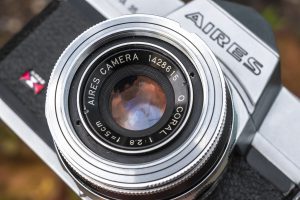
The reason I’m giving the Aires an extremely small amount of latitude, is that by the time of the camera’s introduction, Aires was already in financial trouble. The company had a terrible distribution deal with Kalimar in the United States and not very good distribution elsewhere. Even before its release, the company was on the verge of bankruptcy and the Penta 35 was seen as a last ditch effort to save the company.
Its uninspired design and uncompetitive features didn’t do much to rescue the company and within 2 years after its release, Aires had gone out of business.
For that reason, I rank this only a hair above the Fujicarex II which was made by a healthy company who had the money and resources to do better, they just didn’t. The Penta 35 isn’t a terrible camera, but there’s just nothing memorable about it. It pains me to say this as I generally liked most of the 35mm Aires rangefinders I’ve used and have heard good things about their one TLR, so it would have been cool to see what the company might have been able to do with a long run of 35mm SLRs, but it wasn’t meant to be.
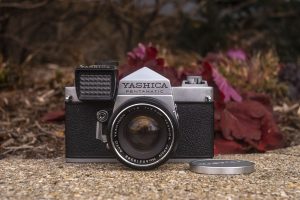
Yashica Pentamatic (1960)
Check out my review of the Yashica Pentamatic S.
Yashica, formerly Yashima, was one of the more successful Japanese companies in the 1950s with their very popular lineup of Rolleiflex and Rolleicord inspired 6×6 Twin Lens Reflex cameras. Yashica TLRs compared favorably to other top tier Japanese TLRs like the Minolta Autocord, and even some German designs, but unfortunately by the late 1950s, TLR sales were slowing dramatically. Professional and amateur photographers were moving away from 6×6 medium format designs and were largely preferring smaller 35mm cameras. With the looming rise of 35mm SLRs, Yashica knew they had to come up with something new.
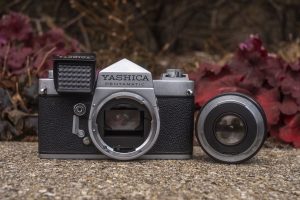
While their instincts were correct, it took them too long to come to it. By 1958, many Japanese companies had already released their first 35mm SLRs, or were already well into development. To help speed up the process of making their own SLR, Yashica would buy Nicca, another Japanese camera maker who was in dire financial trouble and almost ready to go out of business. Although Nicca had never made an SLR either, they did know how to make focal plane shutters, something Yashica didn’t, and was a feature that more and more successful 35mm SLRs had.
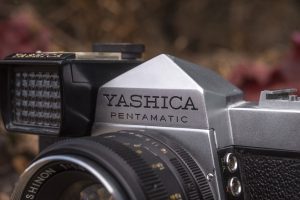
After Yashica’s acquisition of Nicca in May 1958, they got to work on a new SLR which would use Nicca’s shutter design. It would take them until 1960 to release their new camera, which they called the Yashica Pentamatic. The Pentamatic was a good looking camera with an uncluttered and clean design, it featured an all new bayonet lens mount and supported Yashica’s range of excellent Yashinon lenses. The camera had a focal plane shutter with a top 1/1000 shutter speed, and the lenses made for it featured a semi-automatic diaphragm.
On paper, the Pentamatic had a compelling feature set that should have ranked it higher on this list, but the problem it faced that was that in the years between 1958 and 1960, what was expected from a new SLR changed dramatically. Features that were state of the art in 1958 were already outdated by 1960, and the Pentamatic’s use of semi-automatic lenses was not ideal.
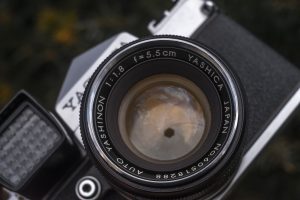
To their credit, Yashica would quickly release two updated models called the Pentamatic II and Pentamatic S that added support for a fully automatic diaphragm, more lenses, and on the S, a self-timer, something that was missing from the first two.
The problem was, by this time, much of the hoopla of new SLRs had already passed Yashica by. Had the company been able to get this camera out 2, maybe even 3 years sooner, the story would have been very different. The Pentamatic would have been a fine SLR in 1957 or 1958, but not 1960 and by then, it failed to impress.
I had an opportunity to shoot the later Pentamatic S and found the experience to be unremarkable. The camera was easy enough to use and I did get great images from it, but there was nothing special about it. Difficulties in adapting its lenses to other cameras or vice versa meant that I couldn’t easily try out other lenses without finding one with the uncommon Pentamatic bayonet, plus missing features like an automatic resetting exposure counter or in body metering was disappointing.
Between the three Pentamatic models, sales were so sluggish that in 1961, Yashica would quickly pivot to the Penta J which used the M42 “Universal” screw mount. This opened the door for Yashica customers to shoot a huge number of Japanese and German screw mount lenses. Combined with an economic price of $150 and under, Yashica SLRs would eventually become popular in the budget segment.
In a way, the failure of the Pentamatic is the reason we have a huge number of really good screw mount Yashica SLRs like the Yashica TL-Super and the Electro AX. Yashica may have waited too long to put out the Pentamatic, but they clearly learned their place in the market and embraced it. For that reason, the Pentamatic moves up a few notches from the bottom of this list.
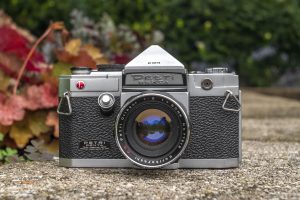
Petri Penta (1959)
Check out my review of the Petri Penta.
If there’s one Japanese camera maker that gets picked on more than others, it is probably Petri. While there was no shortage of discount camera makers in Japan that don’t get as much flak as Petri, it is probably because companies like Cosina and Chinon made mostly run of the mill cameras that were similar to, or copies of other run of the mill models. Petri at least tried to do something different, they just often didn’t do a good job of it.
For Petri’s first SLR (they were still known as Kuribayashi at the time), it was clear that a good amount of effort was put into it. For starters, its release was timely as the camera officially went on sale in September 1959, only a few months after the first Nikon and Canon SLRs, but before Yashica, Konica, or Olympus had anything. Second, the camera was surprisingly well designed, featuring a compact and ergonomic body, with support for the M42 “Universal” screw mount used by Asahi and some German camera makers.
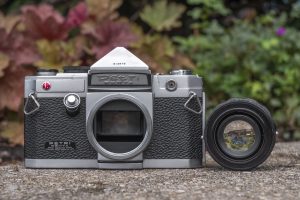
Kuribayashi, to their credit, had no ambitions for a top tier SLR to compete with professional cameras, but rather aimed at the economy market. The Penta had a limited number of shutter speeds from 1/2 to 1/500 second, no metering, no automation, and by choosing the M42 mount, didn’t require users to buy into a new lens mount.
The camera wasn’t all bad though, as the camera had an instant return mirror, automatic resetting exposure counter, film advance lever, and the kit lens was a very good 7-element Petri Orikkor 50mm f/2. But the best part about the Petri Penta was its price. At $149.50 with the f/2 Orikkor, the Petri was cheaper than every other option from Asahi, Minolta, Miranda, Nikon, and Canon, making the Penta the best value in 35mm SLRs at the time.
I shot two rolls through my Penta and found the experience to be similar to the Asahi Pentax K, a camera I gave very high remarks to. The size of the camera was smaller than what others were making and I just felt the control layout was intuitive and fun.
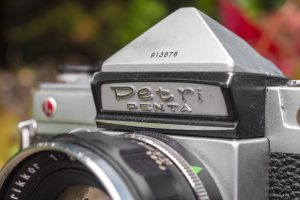
On paper, the Petri Penta was a pretty decent first attempt. Kuribayashi made an attractive and ergonomically designed camera with a great lens and some modern features, while offering support for a large number of other manufacturer’s lenses and was able to sell it for quite a bit cheaper than the competition. The camera definitely lived up to the goals Kuribayashi set for it, but unfortunately, sales were slow, and the camera would be replaced the very next year with an updated model that introduced a new proprietary lens mount.
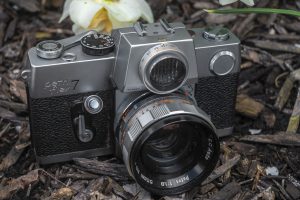
Things would go downhill quickly for Kuribayashi, as later cameras, despite adding support for automatic diaphragms not supported on the original model, would suffer from quality control issues, specifically with its shutter. Unlike most every other SLR with a focal plane shutter which was loosely based off the Leica rangefinder, Kuribayashi’s used an entirely new system which tensioned the shutter with a torsion rod, similar to how a garage door works. The shutter failed often, and earned Petri SLRs a poor reputation in the community. That most Petri SLRs were already seen as discount entry level cameras, it didn’t take long for most consumers to steer clear of them.
Petri would struggle in the market and despite the earlier models having attractive bodies with good fit and finish, later models would become more and more generic looking and have increasingly lower quality. Sales would be so poor, that in the 1970s, Petri would abandon its own mount and revert back to the M42 screw mount, which by then was a quarter century old and much more out of date than the first time they used it in 1959.
This article is supposed to focus only on each maker’s first model, of which the Petri Penta was pretty good, however it is very difficult to look past how quickly Petri gave up on this first model. Later cameras did not innovate, lagged behind the competition in features, and had worse quality control making this a difficult camera to rank any higher on this list.

Mamiya Prismat (1961)
Check out my review of the Argus SLR.
Mamiya’s entry into the world of 35mm SLRs has a bit of an interesting history and is one of the reasons I included the “no prototypes” disclaimer at the beginning of this list. Mamiya’s first 35mm SLR dates back to a prototype called the Mamiya Prism Flex from 1952. Had this camera been released, it would have missed being the first Japanese SLR by only a few months and would be the first with an eye level prism viewfinder. The Prism Flex was a compact and cleanly styled SLR that could have set Mamiya on a trajectory to being one of the world’s premiere SLR makers.
That original model would never make it beyond the prototype stage, and a follow up prototype called the Mamiya Pentaflex would be shown in 1955. The Pentaflex had a body that was very similar to the Prism Flex but had a very ambitious feature set including interchangeable viewfinders, interchangeable lenses, and a TTL metering system (this one I struggle to believe as the prototype images show no sign of this feature actually existing).
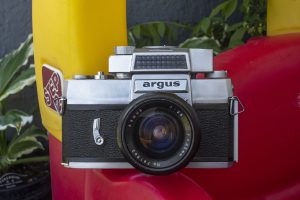
Like the Prism Flex, the Pentaflex would never make it beyond the prototype stage and it would take Mamiya a full six years to release their next SLR. In 1961, the Mamiya Prismat would be revealed, an attractive camera with a design that takes some subtle cues from the company’s earlier prototypes, but is a totally different camera.
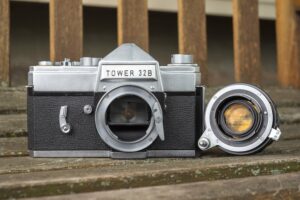
Where the Prism Flex and Pentaflex had innovative features not found on any other models, the Prismat was a rather mundane camera that used the Ihagee Exakta mount, and clunky external linkage for aperture control, no metering, and a fixed prism viewfinder. The Prismat would prove to be a solid, if unremarkable seller, but its greatest legacy was that it was the basis for so many other cameras. Nippon Kogaku would release a version of the Prismat called the Nikkorex F which itself would be later renamed the Ricoh Singlex, the American company Argus would release a Prismat based Argus SLR, and Sears Roebuck & Co, would release several different Tower branded Prismats.
Although I do not own an original Prismat nor have I ever shot one, I have handled and shot the Argus SLR and a number of the Tower variants which I used for the photos in this article, and I found them to be well made cameras that are very capable shooters. Most Prismats and rebadged Prismats have one of Mamiya’s excellent Sekor lenses, and for a short time, you could even get an excellent Canon lens on some versions. While the camera wasn’t very remarkable, it did work well and produced great images.
I struggled where to put the Prismat on this list as it works well, makes good images and doesn’t really do anything wrong. Earlier prototypes suggest that Mamiya had some innovative ideas, even though they didn’t use them. It is a shame that those earlier cameras never saw the light of day or that by the time the Prismat did come out, it lacked any of the innovation of those other models. That the camera did exactly what it needed to do and had a pretty long legacy, being produced throughout the rest of the 1960s under one name or another, earns it a spot in the middle of this list.
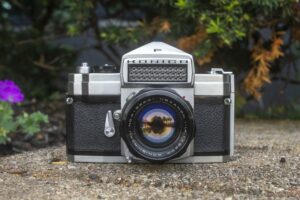
Konica F (1960)
Check out my review of the Konica F.
Of all the cameras on this list, I think the Konica F might be the most attractive camera here, and possibly the one with the highest number of innovative features, but yet, it still only makes it to the middle of the list.
The Konica F was Konishiroku’s first SLR and upon its release in 1960, it aimed to go head to head with top level SLRs like the Nikon F and Canonflex. Like those two cameras, it supported an all new bayonet lens mount, interchangeable viewfinders, instant return mirror, and supported Konishiroku’s excellent Hexanon lenses with automatic diaphragms but added a built in exposure meter, a top 1/2000 shutter speed (Canon would later release the Canonflex R2000 with matching top speed), a moving film plane which would alleviate pressure on film as it is being transported through the camera, and an all new vertically traveling shutter with an unheard of 1/125 flash X-sync speed.
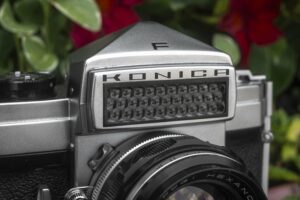
For such a good looking and innovative camera, the Konica F should have been a rousing success, but it wasn’t, being discontinued a year after its release and with only an estimated 1500 – 1600 ever made. But what went wrong?
Two things. First was the camera’s price. With a retail price at launch of $395 with the Hexanon 52mm f/1.4 lens, the Konica F was the most expensive Japanese SLR at the time. Compared to the Nikon F which carried a retail price with f/1.4 lens of $375 and Canonflex with f/1.8 lens for $299.95, the Konica F was a tough sell.
Making matters worse was that the Konica had perhaps the worst new lens mount out there. Although a new bayonet mount that supported automatic diaphragms, it used a fragile external linkage that was prone to fail and made lens swapping tricky, but it also had an unusually small diameter. The narrow opening of the Konica F mount meant that lenses faster than f/1.4 and wider than 28mm would be extremely difficult to design. Furthermore, a narrow diameter makes it harder to adapt with other lenses, and would limit the weight of larger telephoto lenses that could be attached to the camera. This certainly was not something you’d want from a supposed top tier SLR aimed at professional photographers.
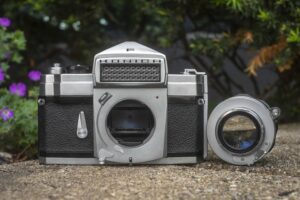
Even the camera’s inclusion of a built in meter which today, seems like a very useful feature to have which the Nikon and Canons didn’t, you have to remember that back then, a professional photographer looking to drop an inflation adjusted amount of over $4000, would have been skeptical of in body metering. Photographers back then weren’t sold on new features and would have been much more used to using either a hand held meter or measuring exposure through some other means, so the inclusion of this feature would have done nothing to counteract the cons of the lens mount or price.
Finally, Konishiroku made the same mistake as Canon by misjudging how valuable a motor drive was to professional photographers. The ability for the Nikon F to support an auxiliary motor drive was huge, and the lack of that feature on both the Canonflex and Konica F further put both models at odds with their intended audience.
While shooting a Konica F for my review, I had mixed feelings about the camera’s ergonomics. While its build quality was undeniably high and the Hexanon lenses it used made great images, I struggled with the location of the shutter release and did not enjoy how the lens coupled to the body.
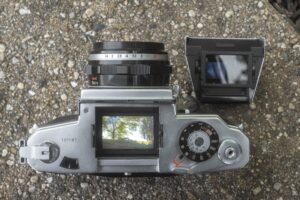
If all you wanted was an attractive and well built 35mm SLR with a great kit lens, in body metering, and had a lot of free money to spend, the Konica F would have been a great choice, however very few people did and the camera sold very poorly. A year later, Konishiroku would release the less expensive and scaled down Konica FS and a few other models using the same bayonet lens mount but with a different shutter, and the lack of the moving film plane feature. In the years immediately following the release of their first SLR, Konica SLRs consistently lagged behind in sales to other Japanese SLRs, and by 1966, the company would scrap the entire lens mount and start all over with a new, and more competitive mount in the Konica Auto-Reflex.
As a collectors item, the Konica F is awesome. It has a cool history, introduced new features, supported great lenses, and looks great on a shelf. As an influential and successful entry into the Japanese SLR market however, it was a failure.
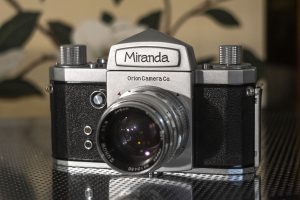
Orion Miranda T (1955)
Check out my review of the Miranda A.
The Orion Camera Company was a maker of various photographic accessories dating back to the 1940s. In 1954, Orion would make a prototype SLR called the Phoenix, a name that would be changed a year later with the release of the Miranda T in 1955. The Miranda was the first Japanese camera to have a pentaprism viewfinder, beating the Pentax by nearly 2 years. For anyone who preferred a waist level finder, the Miranda’s viewfinder was interchangeable and could be used with a hood or other viewfinder accessories, an uncommon feature for the era.
The Miranda T was a pretty advanced camera, especially for a first attempt by a company only known for their accessories. Featuring a cloth focal plane shutter that was quieter than similar designs of the era and supported speeds from 1 to 1/500, the previously mentioned interchangeable viewfinder, and featured quality lenses made by a variety of Japanese optics companies like Zunow and Soligor, there was a lot to like about them.
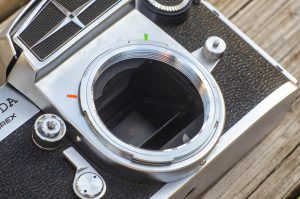
Perhaps one of the Miranda’s most innovative features was its dual lens mount which had both an internal screw thread and an external bayonet. The screw mount had a diameter of 44mm which was very large for its time, and was chosen to allow for a variety of adapters to be made for nearly every other SLR lens mount that existed at the time. Orion used its extensive knowledge of making adapters and accessories for other SLR systems and designed the Miranda with adapting other people’s lenses in mind. This meant that anyone looking to try a Miranda could still use any existing lenses they might already own for another company’s SLR. Early Miranda lenses were made using the 44mm screw mount, but by the 1960s, most Miranda lenses used the external bayonet.
The Miranda T was an attractive and innovative Japanese camera that spawned a large number of variants. Unlike companies like Nippon Kogaku who took their time with new releases, including major updates to each new model, Orion (who would later change their name to Miranda in 1957) preferred incremental updates. As a result, a large number of updated Miranda models would be released almost annually, until the end of the 1960s.
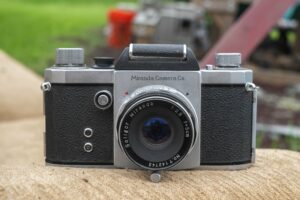
The Miranda T wasn’t a huge seller, but it set the stage for Miranda to be a respected maker who produced cameras of high quality, with advanced features, but at an economic price. Most Miranda cameras produced through the mid 1960s are very well constructed and were just as reliable as any others out there.
Unfortunately, problems with distribution both in Japan and in the United States affected sales, and as a result, the company would start to cut corners on future models. By the second half of the 1960s and into the early 1970s, Miranda cameras suffered from poor quality and were often relegated to discount stores and completely dismissed by serious photographers.
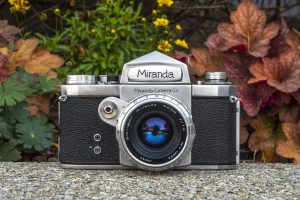
While Miranda’s legacy was hurt by its later reputation, early Mirandas are very good cameras that came with excellent Soligor and Miranda branded lenses, and with an adapter, could use a large variety of lenses designed for other systems. Their pioneering interchangeable viewfinders and dual lens mount were innovative and allowed them to stand apart from the competition, plus that they were able to get a camera out before most Japanese camera makers, gave them an edge in performance.
I am a fan of early Miranda cameras and find them to be very beautiful and fun to use. Although I have never shot a Miranda T as they’re quite uncommon, I do own a similar Miranda S, and have shot many other models like the Miranda A, D, DR, F, and G. That they got ahead of most other companies and offered features no one had seen up until that point should have allowed the Miranda T to be higher on this list, unfortunately, their reputation was irrevocably tarnished, and by the 1970s, the company was mostly forgotten. As much as I like early Miranda SLRs, I can’t put them any higher on this list.
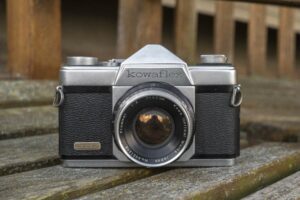
Kowaflex (1959)
Check out my review of the Kowaflex SET-R.
Of the brands on this list, I would suspect Kowa is not one that most would think of when it comes to successful 35mm Japanese SLRs. But for a good stretch of a little more than a decade, Kowa produced a lineup of SLRs consisting of 9 different models, all with leaf shutters, some with fixed and some with interchangeable lenses, and an increasingly advanced feature set.
The original Kowaflex from 1959 came out alongside a rash of multiple other Japanese SLRs. Unlike the more recognizable Nikon, Canon, and Minolta SLRs that were already on the market, the Kowa took aim at a different style of photography. The biggest selling point of Kowa SLRs was its leaf shutter, which unlike focal plane shutters used on many SLRs of the day, supported flash synchronization at all speeds. With a top 1/500 shutter speed, sports photographers could still sync their flashes while stopping motion, unlike the relatively slow 1/30 to 1/60 speeds that most focal plane shutters were limited to. Even the Konica F from a year later topped out at only 1/125, which was considered very fast back then.
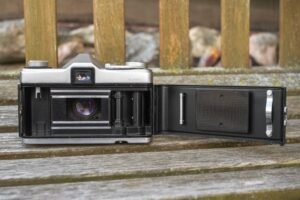
Besides its leaf shutter and Kowa’s reputation with medium format cameras, another thing that was notable about the Kowaflex was how “normal” it looked. In contrast to German leaf shutter SLRs that would soon come out by AGFA, Kodak AG, and Voigtländer, the Kowaflex had a very traditional design without any of the strange ergonomics of its German competition. The Kowaflex had a clean and traditional body with a rapid advance lever, automatic resetting frame counter, and a decently fast 6-element f/2 fixed lens, all in a body that was more compact than models being released by Nippon Kogaku, Canon, and others.
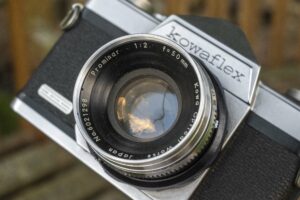
It lacked things like interchangeable lenses or viewfinders, an instant return mirror, or any type of metering, but with a retail price of under $100, the Kowaflex was a solid entry into the world of 35mm SLRs for someone who didn’t have a large budget and hadn’t yet committed to any one particular brand of interchangeable lenses.
Although I do have an original Kowaflex in my collection, I’ve never shot it. I have however, shot a later Kowa SET-R which I have written about. In my review for that model, I found it to be comfortable and fun to use, and its lenses consistently delivered great results. Although the Kowaflex had an entry level feature set, it also had an entry level price, and for anyone who liked the Kowaflex but wanted something with a meter or interchangeable lenses, models with those features would soon follow.
If you’re wondering why such a basic camera appears as high on this list as it does, especially when compared to some seriously more advanced cameras, is that Kowa knew what kind of camera they wanted to make, and that’s what they made. These are good looking cameras that are easy to use and make great photos.
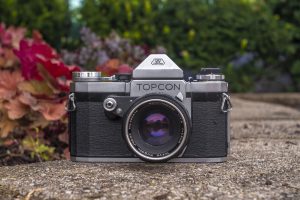
Topcon R (1957)
Check out my review of the Topcon R.
Tokyo Kogaku isn’t a name that too many 21st century photographers know too well, but at one time was one of the biggest suppliers of Japanese optical goods in the world. Tokyo Kogaku’s early history is similar to Nippon Kogaku’s as both companies were major suppliers for the Japanese military. Nippon Kogaku supplied the navy and Tokyo Kogaku the army. After the war, the company would be well known as a supplier of lenses and other optical goods for other companies. Tokyo Kogaku would also release successful folding cameras, 35mm rangefinders, and even a couple TLRs.
But their first 35mm SLR, the Topcon R, was a heck of a camera. Beating Nippon Kogaku to market by almost 2 years, the Topcon R had a large and rugged all metal body, interchangeable viewfinders, an instant return mirror, supported lenses with automatic diaphragms, and by virtue of its lens mount, supported a huge range of excellent Japanese and German lenses.
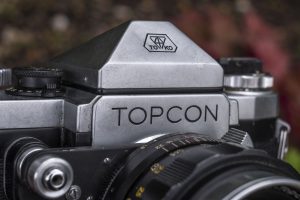
There was a ton to like about the Topcon R, including the models that would follow it like the Topcon R3 Automatic and Topcon RE Super. When Nippon Kogaku released their Nikon F SLR in 1959, Tokyo Kogaku was the only company to make a camera with a feature set that came close to Nikon’s professional level SLR.
The Topcon R is a great camera that has quite a bit in its favor. It supported many modern features not consistently found on other cameras, had excellent build quality and ergonomics, the support of one of Japan’s premiere optics companies, and that its introduction in 1957 meant it beat out many other less advanced Japanese models. Everything I’ve said so far should suggest a model that appears near the top of this list, and that would be true, except for one thing, the lens mount.
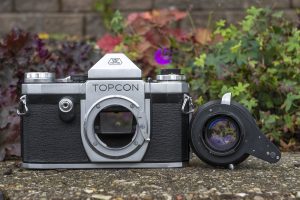
When designing the first Topcon SLR, instead of coming up with their own bayonet design, or using a screw mount like the Germans and a couple other companies, the Topcon R used the Ihagee Exakta bayonet. Which on paper, kind of made sense, as at the time, the Exakta SLR was the world’s most successful 35mm SLR and already had a TON of excellent lenses available for it. By using the Exakta mount, owners of the Exakta could try out a Japanese SLR and keep using their existing lenses. For those who didn’t already own an Exakta, you could buy a Topcon R and have access to many used Exakta lenses which were often available at discount pricing.
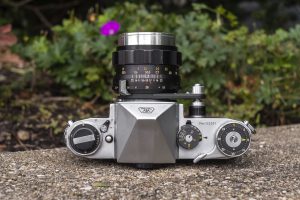
While I do understand why the decision was made, it proved to be a poor one as by the late 1950s, the Exakta bayonet was showing its age. First designed in 1936, the Exakta bayonet had a very narrow throat diameter which meant it could not support ultra fast or wide angle lenses. Designing a lens with an Exakta mount and a maximum aperture larger than f/1.4 was difficult as were lenses wider than 28mm. In addition, the small size of the mount meant that the camera would struggle with heavy telephoto lenses as the mount was physically smaller.
Sure, for people looking for lenses in the 28mm to 135mm sweet spot, there were many available, most of which had excellent optics, but the lens mount did hold back future development of the camera, and I can’t help but wonder if professional photographers in the late 1950s had concerns with buying into a new SLR system that used a lens mount that was already over 20 years old.
I have used both an original Topcon R and the rebadged Beseler version and thoroughly enjoyed both. I never changed lenses on either of mine, so I had no need to mess with the lens mount, but for a camera made in 1957, I found it to be easy to use. Its large and heavy body inspired confidence and all of the camera’s controls felt very smooth and without grit, which was impressive considering its greater than half century age.
There is a lot to like about the Topcon R, and it might seem trivial for me to rank this camera in 6th place on this list just because of its lens mount, but it is worth mentioning that the difference between the top 5 is very small, so even one notable flaw is enough to drop it to this spot on the list.
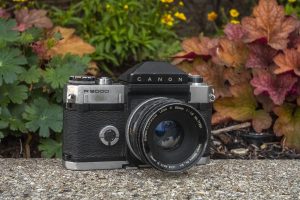
Canonflex (1959)
Check out my review of the Canonflex R2000.
Canon, as we all know is one of the most successful optics companies of all time. From the very first Seiki Kogaku rangefinders from the 1930s, to their current slate of digital SLR and mirrorless cameras, Canon’s dominance in the world of camera making is undisputed.
When Canon was developing their first SLR in the late 1950s, they knew that they would have competition. The company could already see what the Germans were doing as well as some other Japanese companies like Asahi and Miranda. Also, knowing that their primary competitor, Nippon Kogaku was working on their first SLR, Canon aimed for the skies and upon its release in May 1959, delivered what they thought was a world class SLR that would appeal to professional photographers the world over.
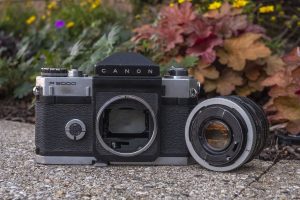
Today, we have the benefit of hindsight to know that’s not quite what happened. Although the first Canonflex would turn out to be a very rugged and high performance SLR that would eventually have a large system of excellent lenses, Canon’s first SLR was overshadowed by the Nikon F almost immediately.
The camera had a number of ergonomic and technical issues. The most glaring was that the bottom mounted trigger film advance got in the way of the tripod socket, which meant that it was difficult to advance the film while on a tripod. The lens mount had multiple external linkages that could get out of sync if you removed a lens with the shutter cocked, and then reinstalled it later. Upon its release, there were only 3 available lenses, none of which were wide angle, and of the ones that were available, had a confusing double aperture ring which worked like a preset lens. Finally, unlike the Nikon F, the Canonflex had no support for an external motor drive, which meant that photographers had no option for high speed photography.
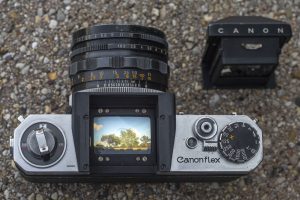
A year after its release, Canon would put out an updated version called the R2000 with a top 1/2000 shutter speed, but it wasn’t enough to change the public’s minds, and after two more scaled down versions of the Canonflex, Canon would avoid the professional segment for a little more than a decade.
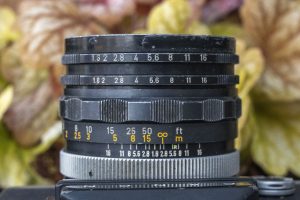
For the missed opportunity that the Canonflex was, it is easy to dismiss it as a failure not worth your time, but fortunately, that’s not true. While yes, the Canonflex didn’t sell well and it had a truly terrible lens mount with complicated preset diaphragm feature, and yes, it was difficult to advance the film with the camera on a tripod, but once you get past those missteps, the Canonflex is actually a really terrific camera to use.
In my review for the updated Canonflex R2000, I praised the camera’s smoothness and speed at which I could fire the shutter using the bottom trigger film advance. Although the preset aperture design of the lens definitely took some getting used to, it clearly didn’t have a negative effect on my results as I got entire rolls of great images. I loved the bright and easy to use viewfinder, and the build quality of the camera is as good as anything Nippon Kogaku was making.
The Canonflex is an interesting camera because history should tell us it was a failure, yet Canon as a company would eventually go on to make many world class SLRs, and by the 1980s, start to beat Nikon at their own game. The camera is well built and smooth to use, and of course supports optically excellent lenses, meaning any photo you take with one should come out as good as any out there, and for that reason, against all odds, this “failure” deserves its spot near the top of this list.
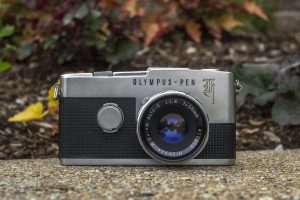
Olympus Pen F (1963)
Check out my review of the Olympus Pen F.
This was a tricky one that I almost didn’t include in this list. The first camera that comes to mind when I think of “first Olympus SLR” is the OM-1 (formerly M-1), from 1972, except that I forgot that the Olympus Pen F and FT SLRs from the mid 1960s are still 35mm SLRs, they’re just half frame SLRs. I hemmed and hawed whether I should exclude half-frame, but if I did that, the OM-1 still wouldn’t be right, as the Olympus FTL full frame 35mm SLR came out the year before. So rather than introduce unnecessary debate into this list, I just went with the very first Olympus SLR that used 35mm film, and that would be the original double stroke Olympus Pen F from 1963.
It is probably a good thing I did, as the Pen F was a heck of a camera and one of the go to cameras for half frame fans all over the world. By the early 1960s, Olympus was selling half frame Pen cameras by the truckload. Half frame photography had completely captivated Japan, and was selling well in western countries as well. Half frame 35mm cameras were released by nearly every Japanese and German maker, even Nikon and Leica had half frame versions of their rangefinders, but Olympus was the first to release a dedicated half frame SLR.
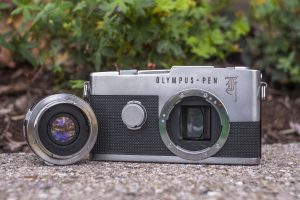
Designed by Maitani Yoshihisa, the man credited with the original Pen, the OM-1, and the Olympus XA compact, the Pen F had some serious pedigree. Featuring a unique and cleanly designed body which concealed the pentaprism within the body, an all new bayonet lens mount, support for a clip on exposure meter, and a selection of extremely good lenses, the Pen F was an immediate success.
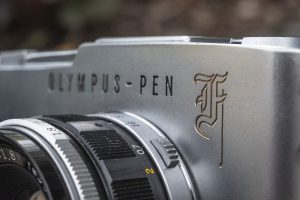
Although the Pen F didn’t really have any new or innovative features not already found on other SLRs, by creating an SLR camera that looked unlike anything out there, in a small and compact body with a rotary focal plane shutter with top 1/500 shutter speed, Olympus proved to the world that half frame was no longer reserved for cheap and simple scale focus cameras and that world class razor sharp images could be taken with the economy of up to 72 exposures per roll.

The Olympus Pen F would be followed up in 1966 and 67 with the Pen FT and FV, but through no fault of the camera, would be the last half frame 35mm SLRs the company would make. The popularity of half frame would fall almost as fast as it had risen and by the end of the 1960s, demand for a premium half frame SLR was small, plus more compact full frame SLRs were becoming more common along with the prices of film getting cheaper, negating two of the primary benefits the Pen F enjoyed over full frame SLRs.
So while the Olympus Pen F half frame 35mm SLR camera doesn’t have a long legacy on photography, it was an enormously successful model that is still desirable today by collectors and shooters alike. I’ve shot mine many times and marvel at its compactness, quality, and ease of use.
The camera has proven itself to be reliable, fun to shoot, and capable of amazing images. As an added bonus to its legacy, in recent years, Olympus would reuse the Pen brand name and styling of the Pen F on a new line up of digital mirrorless cameras.
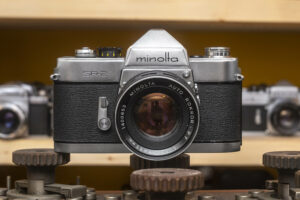
Minolta SR-2 (1958)
Check out my review of the Minolta SR-2.
And now we get to the hard part of the list. Having to continue to rank some of the best first Japanese 35mm SLRs ever made is not easy. How do I say one model is better than another when the margin of difference is so small? The Minolta SR-2 from 1958 was an outstanding camera that did almost everything right. It beat out first SLRs by a number of Japanese camera companies, it introduced a brand new bayonet lens mount that was actually good, it had great ergonomics, supported great lenses, and was reliable.
If I were to rank the entire Minolta SR lineup, including the SR-1, SR-1s, SR-3, and SR-7, I would have a difficult time coming up with any cons, but one minor thing about the SR-2 which the models higher on this list didn’t have a problem with, was that it was produced for a very short period of time. The SR-2 was in production for barely over a year with less than 20,000 thought to have been made.
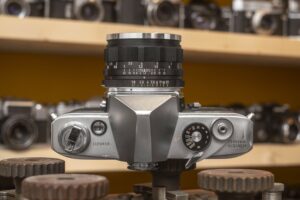
This had nothing to do with there being anything wrong with the camera, but rather that by getting their camera out in 1958, and so much competition hitting the market so soon after, Chiyoda Kogaku had to quickly update it and re-release the camera as the Minolta SR-3, which is the same exact camera, only adding support for a clip-on exposure meter. Had the SR-2 supported that feature from the beginning, it likely would have been produced for much longer, but as it is, the SR-2 was a short lived model that was quickly replaced in Minolta’s lineup.
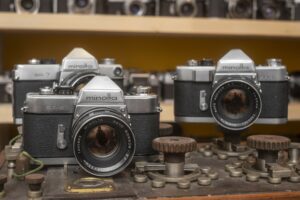
Beyond that though, the Minolta SR-2 is almost perfect. It has great ergonomics, a great viewfinder, support for Chiyoda Kogaku’s best Rokkor lenses, and is a lot of fun to shoot. That it launched Minolta into the SLR-stratosphere with extremely popular and long lived models like the SRT-101, XE-7, XD11, and X-700 further cements its legacy.
In my review for the Minolta SR-2, I found that it was just as easy to get great images from it as Minolta SLRs from a decade later. In addition, I was constantly impressed with how modern the camera felt, especially considering the year it was made.
Minolta would eventually abandon the manual focus SR mount in the mid 1980s with the release of their first autofocus SLR, the Maxxum 7000, but would continue building SR mount lenses into the 1990s. Today, manual focus Minolta SLRs are very popular with collectors and users alike, and while few will likely seek out Minolta’s very first SLR, its impact was definitely felt.
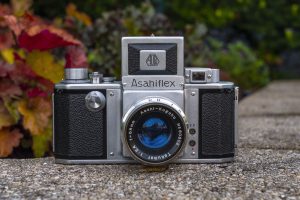
Asahi Optical Asahiflex (1952)
Check out my review of the Asahiflex IIa.
The criteria for making this list was whether or not the designers of each company’s first SLR got it right, what its impact was on the company’s legacy, and whether I like it, and the Asahiflex definitely scores high marks for all three. Adding an extra layer of cred in its favor, that Asahi Optical’s first SLR came out in 1953, way before most Japanese companies further proves how much they got right on not only the first Japanese SLR, but the first ever camera made by Asahi.
The man responsible for the Asahiflex was Saburo Matsumoto who was a keen businessman, but had no experience making cameras, so he assembled an all-star team consisting of people with experience working at other Japanese optical companies to build him a camera. Intrigued by the Kochmann Reflex-Korelle and the Leica rangefinder, Matsumoto wanted a camera that combined the best of both into a single, compact, and high quality model.
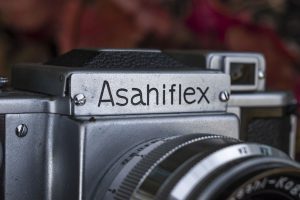
When the first prototypes were shown in 1951, leadership at Asahi and the Japanese press were very excited. The camera would first debut in February 1952 to lukewarm sales. The lack of demand had little to do with the camera, but rather most Japanese photographers hadn’t ever used an SLR and didn’t understand the appeal of it. Asahi would press on, releasing updated models with innovative features such as the first quick return and instant return mirrors. The Asahiflex used a 37mm screw mount and supported the company’s excellent lineup of Takumar lenses.
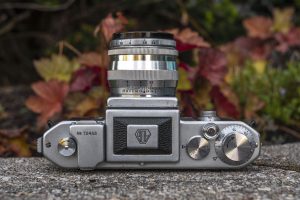
The build quality and design of the body were on par with what an SLR version of a 1950s Leica might have looked like. The camera featured only a waist level finder as pentaprisms were still not yet standard, but that was hardly seen as a con at the time. The Asahiflex would eventually catch on and become the darling of the Japanese photo industry. The American department store retailer, Sears Roebuck & Company would agree to sell various versions of the Asahiflex under its own Tower brand, allowing many western photographers not only their first glimpse at an SLR, but a Japanese camera as by the mid 50s, the sale of Japanese cameras was still a fraction of the market.
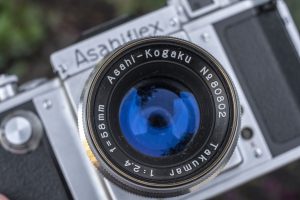
While the Asahiflex series was very popular, its follow up, called the Pentax would be an enormous success. The first Asahi Pentax would switch to the more widely used M42 screw mount and would continue to innovate with new features, and support for a growing catalog of world class Takumar lenses.
The Asahiflex’s introduction to quick return mirrors, helped eliminate one of the most glaring cons to SLRs, which was mirror blackout, and further cemented the screw mount as the most widely used Japanese lens mount of the 20th century. If there was one really tiny misstep with the original Asahiflex was its smaller M37 mount which was incompatible with lenses made by any other company. Had it came with the M42 mount from the very beginning, I wouldn’t have a single negative thing to say about them, as I suspect, neither would anyone who has ever used one.
The legacy of the Asahiflex is directly tied to Pentax SLRs which were some of the best selling cameras of all time. The name Pentax would eventually become the name of the company itself, and would continue on well into the 21st century with a lineup of Pentax digital SLR and mirrorless cameras.
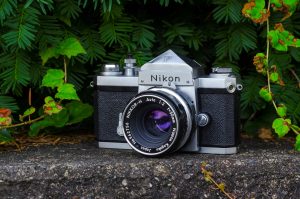
Nikon F (1959)
Check out my review of the Nikon F.
I am no stranger to “Best Of” or “Top 10” lists online. There’s nothing more enticing for a blogger than to release a list of something and excite readers with a controversial ranking of something. When it comes to the number one camera on this list, I doubt many people will be surprised that in my opinion, no other camera got so many things right, and made such a significant impact on the photographic industry, than the Nikon F.
Much has been written both on this site and elsewhere about the strengths of the Nikon F system, its build quality, reliable operation, successful Nikon F mount, and the huge number of lenses and accessories that were made, earned it a spot at the top of many ‘best of’ lists. What might surprise people who don’t know the history of this camera, is that the greatest thing that Nippon Kogaku did when developing their first SLR, had little to do with any one particular feature, rather it was their dedication to listening to the professional photographers that they intended to sell their cameras to.
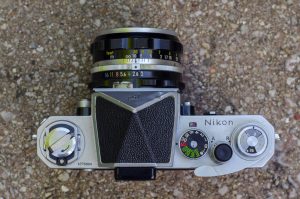
Ever since before the Korean War, Nippon Kogaku’s Tokyo office had the ear of the best professional photographers of the era. LIFE Magazine photographer David Douglas Duncan famously “discovered” Nikkor lenses on a chance encounter with a young Japanese photographer named Jun Miki. Upon witnessing the optical superiority of Nikkor lenses compared to the German lenses, Duncan used Nikkor lenses on his Leica camera while on assignment. His impressive images enticed other photographers to trade in their German optics for Nikkor lenses.

In the years during and after the Korean War, Nippon Kogaku regularly had the ear of photographers stationed in Japan. Nippon Kogaku built up good will by servicing not only its own cameras and lenses, but also those by its competitors, for free. In exchange for their efforts, the designers and engineers got to see and hear what the pros were doing and what they wanted.
When work began on their first SLR, Nippon Kogaku was always listening. The pros were less concerned with innovation, but instead wanted quality, precision, and reliability above everything else. They wanted cameras that could change film quickly, they wanted motor drives to shoot fast action, mirror lockups for long exposures, an easy and fast bayonet lens mount, and they wanted the best glass money could buy.
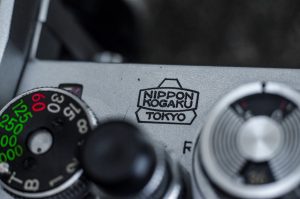
Nippon Kogaku listened to the pros and delivered exactly what they asked for, a top tier reliable SLR with all the features they wanted, and a long list of not only lenses, but accessories as well. Despite being released within days of Canon’s Canonflex SLR, there was never a debate which one the pros preferred. The battle between the first generation of professional 35mm SLRs was over immediately, and the Nikon F would go on to become the most successful camera system of the 20th century. That first camera would remain in production for 13 years, would see service in war zones, would fly to the moon, and would survive the harshest desert and arctic climates. When its successor, the F2 was released in 1972, it would see a host of incremental improvements, but no radical changes. The first time the Nikon F system would see a significant redesign would be 1980 with the release of the F3, twenty one years after the first F.
Nikon SLRs have been at the forefront of photography for a lifetime of photographers. With regular service, these 60 plus year old cameras are just as good and reliable and make just as great of photographs as the day they were made. Throughout the 1950s, the Japanese photo industry was well on its way toward proving it was a serious competitor to German models, but the Nikon F was both Nippon Kogaku’s and the entire Japanese Photo Industry’s defining moment. From the first day it went on sale, any debate was put to rest over what style or brand of camera was number 1 in the world.
Who Did I Miss?
I can already hear it now, despite my best efforts to review every first Japanese 35mm SLR, I know there’s some I missed. There were other models by Zunow, Ricoh, Cosina, Chinon, and probably a few more obscure companies which aren’t here.
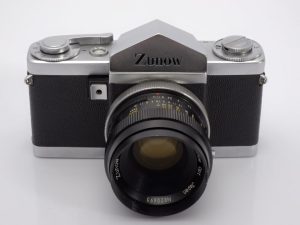
In regards to the Zunow, the reason I left it off this list is I have absolutely no information about them. I’ve never shot one, I’ve never handled one, and I’ve never seen one in person. The information I have is limited to what anyone can read on camera-wiki and other sites, so I didn’t feel like I could objectively rank it here. Had I included the Zunow, it likely would have ranked pretty high on this list as it was a compact and good looking camera, it supported lenses with automatic diaphragms before most other Japanese companies, and it came with Zunow’s excellent lenses. Unfortunately for it, with less than 500 ever thought to have been made, the Zunow is one of the rarest SLRs ever made and is so hard to find, I likely will never be able to form my own opinion of it.
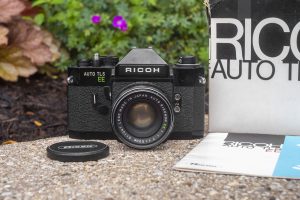
As for Ricoh, while Riken made some pretty cool cameras and some decent 35mm SLRs, the company’s first SLR, the Ricoh Singlex was actually a rebadged Mamiya Prismat. Their second SLR, the Singlex TLS, I have a sneaking suspicion it was made by Chinon. Ricoh eventually would produce some SLRs like their fairly respectable XP and KR series, but these were so much later than the other cameras in this list, plus it is not exactly clear which one was truly first, that I didn’t bother including any.

I’ll group both Chinon and Cosina together, despite them being separate Japanese companies that produced a great deal of SLRs. A bulk of these models were produced for other manufacturers as OEM designs. Cameras sold with the name Argus, Exakta, Alpa, GAF, Canon, Nikon, Voigtländer, and many others were built by one of these two companies. Like Ricoh, with so many models coming way later than others on this list and a clear picture of their total output difficult to realize, I didn’t include any by these two companies here.
And then of course, there’s the weird Japanese 35mm reflex cameras like the Samocaflex, Toyoca 35, and Yallu Flex which aren’t SLRs at all, but in fact are 35mm twin lens reflexes. Maybe one day I’ll do a comparison of these models!
So that’s my take on the first Japanese 35mm SLRs and how I would rank them based on success, legacy, and what it is like to shoot them. How did I do? Would you have placed these in a different order, or are there any cameras I missed? Let me know in the comments below!

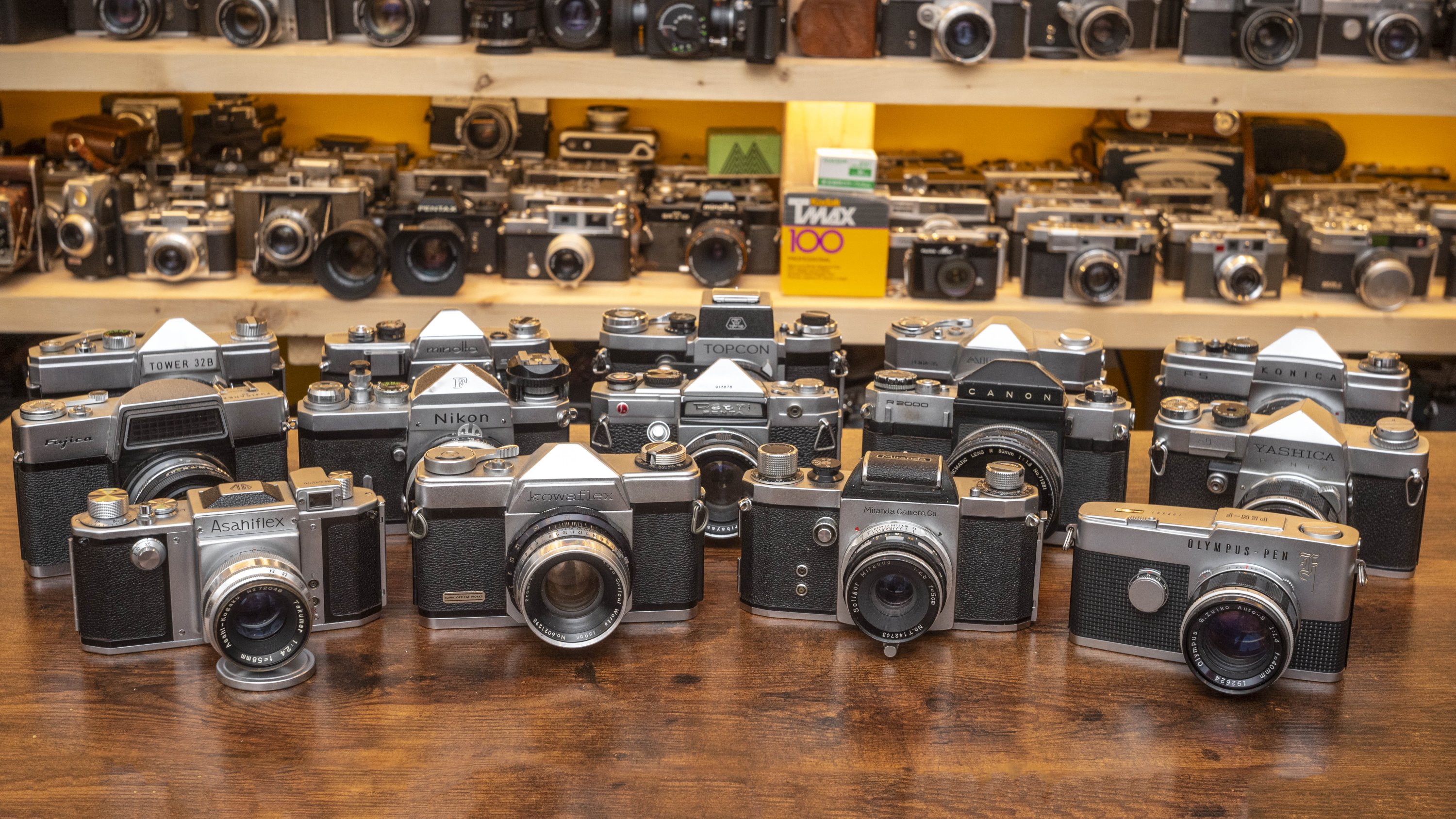
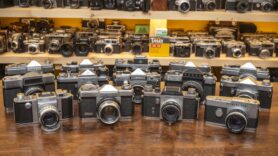
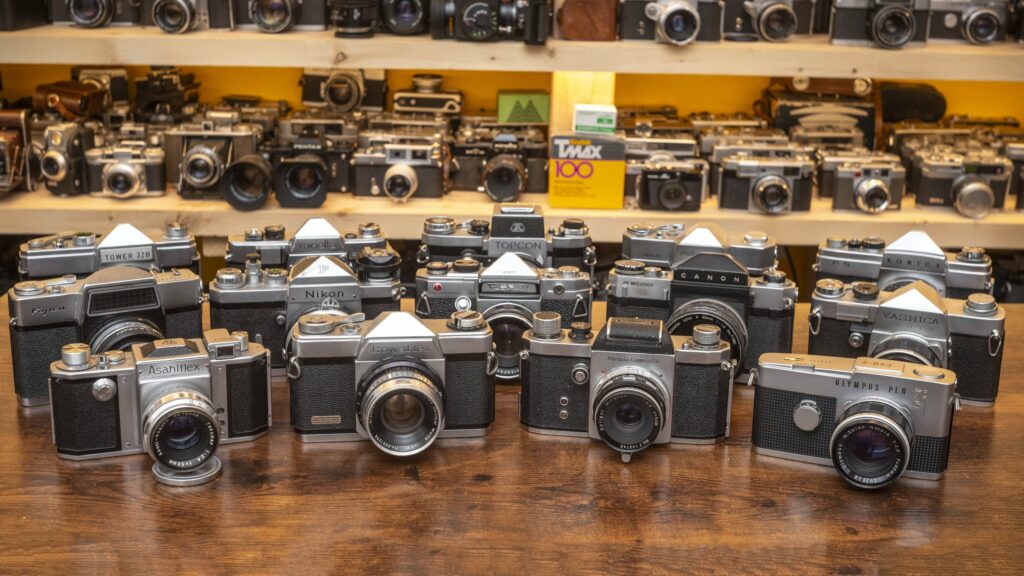
You have vastly overrated the original Asahi Pentax. To be sure, there was the instant return mirror; but in it’s place I’d chose the contemporary Contax S: pentaprism viewing, 42mm lens mount, non-rotating shutter dial. Which would you rather use?
The Contax S is a fine camera, I have two of them and even reviewed the very similar Pentacon FM on this site, however it is not Japanese.
If I was including German SLRs in this list, I would probably rank the KW Praktina higher than the Contax though.
The original Asahi Pentax had a pentaprism and the same 42mm lens mount as the Contax S. As for the differences, if I had to choose between a camera with an instant return mirror and a reliable shutter with a rotating dial and a camera with a notoriously unreliable shutter with a non-rotating dial and a viewfinder that remains dark until the camera is rewound, I’d rather use the Pentax.
What a well written article and what a trip down history lane. Was a fun and informative read.
I have to add my voice to the criticisms of where the Asahiflex ended up. Yes, they were the first Japanese SLR camera, and much earlier than others. But you’ve spent much more time actually talking about their later (very good )models, and much less talking about a camera without an instant return mirror, slow speeds, or a pentaprism, and sporting an F/3.5 lens, for a system that never had a wide angle offered by the manufacturer. In contrast, when the Orion Miranda T arrived it had an F/1.9 lens by a very well regarded manufacturer, a removable pentaprism, and slow speeds. It could compete with the best anywhere in the world at that moment. Adapters were available to fit M42 and Exakta lenses, so the selection was massive. It seems like the list is more based on where certain manufacturers ended up, than as an actual examination of the cameras involved.
I have a Ricoh Singlex (F-mount) peeking at me on a shelf. I bought it out of curiosity, purely for the lens, and haven’t put a single roll through it yet. However, for a budget camera it has a reassuring heft to it and I’m quite intrigued by the Copal Square shutter in it. Insofar as I’m any judge of the matter, my encounters with Copal Square shutters over the years have been entirely fault-free, but this being an early one may have been more problematic.
Nevertheless, I am suprised that Nikon decided to go with the travelling blind shutter on the F, when the Copal Square was available. I suppose they decided to stick with what they knew best.